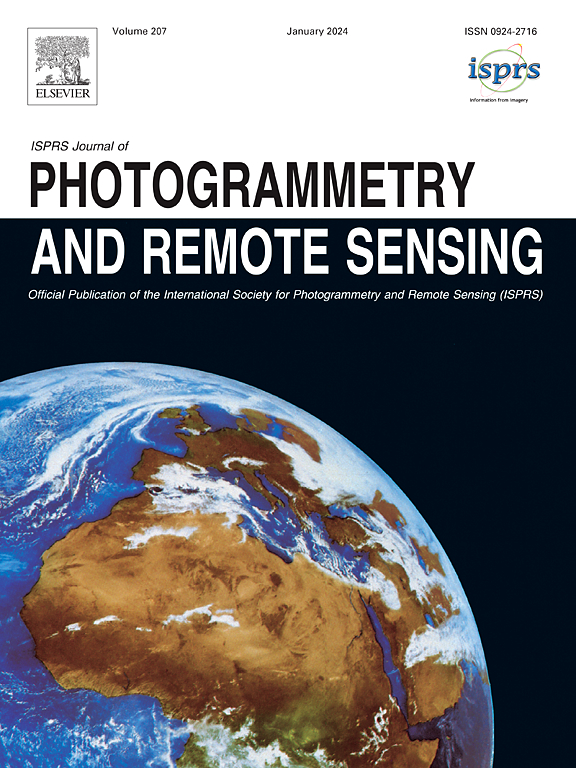Photogrammetric system of non-central refractive camera based on two-view 3D reconstruction
IF 10.6
1区 地球科学
Q1 GEOGRAPHY, PHYSICAL
ISPRS Journal of Photogrammetry and Remote Sensing
Pub Date : 2025-02-27
DOI:10.1016/j.isprsjprs.2025.02.016
引用次数: 0
Abstract
Due to the harsh construction environment of tunnels, the visual system must be fitted with a sphere cover of a certain thickness. The visual system with an optical sphere cover invalidates conventional measurement methods. Therefore, this paper provides a comprehensive visual measurement method using spherical glass refraction. First, the spherical glass refraction imaging is modeled using a geometry-driven camera model. Second, a three-parameter calibration method for the optical center offset unit vector, incident optical path offset distance, and optical center offset distance was proposed to accurately characterize refractive distortion. Then, a dynamic interval (DI) based on angle and depth constraints is introduced, and a DI-SGM algorithm utilizing the semi-global stereo matching method is developed to solve the polar constraint failure problem under refraction. Finally, an improved binocular parallax method that uses refraction image pairs is proposed and demonstrated to be effective and stable under spherical refraction using effectiveness and comprehensive data experiments. The constructed DI has narrow characteristics. The imaging model presented in this paper has an average space reconstruction error of only 0.087 mm. The maximum measurement error for sphere center distance is only 0.157 mm, which is comparable in accuracy to the case with no refraction. The proposed method provides an effective approach for applying visual measurement methods under refractive effects, thereby improving the visual system’s reliability in tunnel environments.
基于二视图三维重建的非中心折射相机摄影测量系统
由于隧道施工环境恶劣,视觉系统必须安装一定厚度的球罩。带有光学球罩的视觉系统使传统的测量方法失效。因此,本文提供了一种利用球面玻璃折射的综合视觉测量方法。首先,采用几何驱动相机模型对球面玻璃折射成像进行建模。其次,提出了光心偏移单位矢量、入射光路偏移距离和光心偏移距离的三参数标定方法,以准确表征折射畸变;在此基础上,引入了基于角度和深度约束的动态区间(DI),并提出了一种利用半全局立体匹配方法的DI- sgm算法来解决折射条件下的极坐标约束失效问题。最后,提出了一种利用折射像对的双目视差改进方法,并通过有效性和综合数据实验验证了该方法在球面折射下的有效性和稳定性。所构建的DI具有狭窄的特性。本文提出的成像模型平均空间重构误差仅为0.087 mm。球心距的最大测量误差仅为0.157 mm,与无折射情况的测量精度相当。该方法为屈光效应下视觉测量方法的应用提供了有效途径,从而提高了隧道环境下视觉系统的可靠性。
本文章由计算机程序翻译,如有差异,请以英文原文为准。
求助全文
约1分钟内获得全文
求助全文
来源期刊

ISPRS Journal of Photogrammetry and Remote Sensing
工程技术-成像科学与照相技术
CiteScore
21.00
自引率
6.30%
发文量
273
审稿时长
40 days
期刊介绍:
The ISPRS Journal of Photogrammetry and Remote Sensing (P&RS) serves as the official journal of the International Society for Photogrammetry and Remote Sensing (ISPRS). It acts as a platform for scientists and professionals worldwide who are involved in various disciplines that utilize photogrammetry, remote sensing, spatial information systems, computer vision, and related fields. The journal aims to facilitate communication and dissemination of advancements in these disciplines, while also acting as a comprehensive source of reference and archive.
P&RS endeavors to publish high-quality, peer-reviewed research papers that are preferably original and have not been published before. These papers can cover scientific/research, technological development, or application/practical aspects. Additionally, the journal welcomes papers that are based on presentations from ISPRS meetings, as long as they are considered significant contributions to the aforementioned fields.
In particular, P&RS encourages the submission of papers that are of broad scientific interest, showcase innovative applications (especially in emerging fields), have an interdisciplinary focus, discuss topics that have received limited attention in P&RS or related journals, or explore new directions in scientific or professional realms. It is preferred that theoretical papers include practical applications, while papers focusing on systems and applications should include a theoretical background.
 求助内容:
求助内容: 应助结果提醒方式:
应助结果提醒方式:


